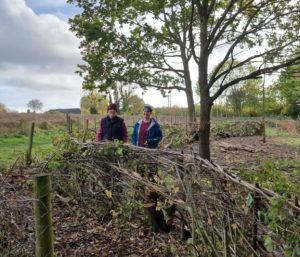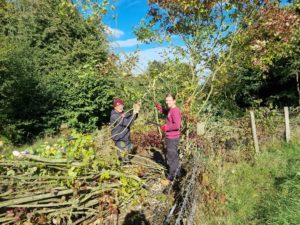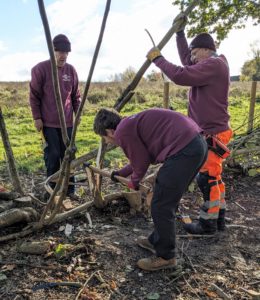Sharing age-old crafts for future green skills
For those who love being out in nature, the idea of turning that passion into their dream job can feel like exactly that – a dream. Learning new skills, securing funding and finding the right opportunities are just a few of the challenges faced by new conservationists.
But it’s never been more important to safeguard the future of the planet, and to do that, we need to make green jobs more accessible. It’s a vision shared by Earth Trust volunteer hedgelayer Martin Barrett, who with his fellow volunteers, is keen to support the next generation.
Martin became a hedgelayer seven years ago after meeting Earth Trust volunteers Mike and Bill at a local conservation group. They’ve worked as a team ever since, and they’re now sharing their craft with more volunteers.
This season they’re working with Laura and Finn, who are both hoping to develop their careers in conservation.
Supporting new conservationists, building green skills

Laura had always had an interest in nature, and enjoyed hiking and biking. After a career in the humanitarian sector, she decided it was time for a change and shifted her focus to working in the environment.
She began studying part time for an MSc in sustainability and ecology, and volunteered with Earth Trust to pick up more practical skills alongside this.
When a chance came up to work with the hedgelaying team, Laura knew that it would give her valuable experience.
“Hedgelaying just makes sense – it’s like rewilding on a small scale. It fulfils the purpose of keeping livestock fenced in, and provides more habitat for wildlife.” Laura
Finn had been studying wildlife and conservation at college, and applied to Earth Trust to do a work experience placement. He then became a regular volunteer, working outside and gaining hands-on experience.
Having done a little bit of hedgelaying at college, Finn had always been keen to do more, so when Martin, Mike and Bill asked if anyone wanted to join them, it was an opportunity that he couldn’t turn down.
“I’ve really enjoyed it, but it’s a lot trickier than they make it look … Especially with the binding – the branches are a lot harder to tie together than you think!” Finn

The art of hedgelaying
Martin describes hedgelaying as “a traditional craft with a modern relevance”.
While its popularity dipped with the introduction of barbed wire and machine cutting, it’s now recognised as a key part of sustainable farming and supporting ecosystem services, and it even featured on the sustainability and biodiversity coronation stamp earlier this year.

To lay a hedge, a cut is made at the base of the tree, and the trunk is then eased over so that it lies at an angle. Wooden stakes support the hedge, and “binding” (long, thin pieces of malleable green wood such as hazel or willow) is twisted along the top to hold it all in place.
After laying, the growth from new shoots makes a thicker and healthier hedge which prevents livestock from escaping and provides vital habitat for wildlife. A laid hedge can also act as a windbreak, reduce soil erosion – and become a beautiful part of the landscape.

Learning to lay
Martin describes his early years of hedgelaying as “getting stuck in” as an extra pair of hands, but hopes to offer a more structured approach for those learning with the team now.
Each week Laura and Finn practise a particular skill such as laying or binding, and they rotate round within the team until they’ve completed each section of hedge. Martin hopes to expand on this, with time looking at the ecology and heritage behind hedgelaying as well as teaching the practical side of it.

Looking to the future
Volunteering has enabled Finn to practise the skills he learnt at college, and it gave him a confidence boost, too: “I’m hoping to continue hedgelaying because I’m really enjoying it. Since volunteering I also think I’m talking to and engaging with people more than I used to.”
Finn has now successfully applied for an internship with the RSPB, and will be joining them in November, while Laura will begin a traineeship with BBOWT next spring, where she’ll be able to continue working outside in nature. After that, Laura hopes to find a role where she’ll be able to combine this experience with her understanding of land management strategy and her passion for rewilding.
“I really enjoy my afternoons learning from Martin, Mike and Bill. They all have different expertise and all ask each other questions which means I feel I can do the same. I’m so grateful that they are sharing their experience with me.” Laura
Meanwhile Martin continues to be driven by the impact he can have not just by volunteering as a hedgelayer, but by passing on his knowledge to future hedgelayers, too, securing the future of this countryside craft.